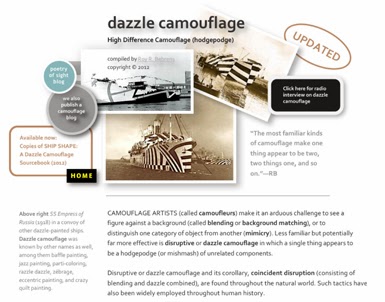 |
| Philip Little (c1917), battleship disguised as island |
We've discovered something rather odd. It's an unusual painting in the collection of the
National Archives and Records Administration (NARA). It is undated (but presumably goes back to 1917) but bears the very clear signature of
Philip Little, Salem, Mass. The most curious thing about it is foretold by its title:
Battleship camouflaged as "An Island." This is followed by a note that reads:
Canvas screens painted appropriately would be used, as in some foreign service. Boston Navy Yard. Zooming in on it on screen, it becomes apparent that the painting was made on the surface of a line drawing (or diagram) of an "outboard profile" of a World War I-era ship, identified as the USS
Delaware, an American dreadnought battleship. Shown
below is a close-up of a detail of this behemoth dressed up as an island, while
above are three other views, including the entire painting, the artist's signature, and the label that's glued to the surface. Odd indeed.
 |
| Philip Little (c1917), battleship disguised as island |
So who was
Philip Little (1857-1942), and how and when was he involved in ship camouflage? There is no shortage of sources, online and otherwise. In the
Boston Sunday Globe (September 9, 1917, p. 38), there is a news article by (
Globe art critic) A.J. Philpott titled
IN CAMOUFLAGE WAR MAKING DECEPTION INTO A FINE ART. It's a substantial article, near the end of which there is this note—
Philip Little, the Salem artist, who paints both landscapes and marines and who is one of the foremost painters in the country, recently experimented with camouflage on a boat with very remarkable success. It is men of his stamp who should be called on for service in this new emergency.
This may be in reference to Little's proposal (above) to disguise a battleship as an island, or it may refer instead to his other attempts at ship camouflage. In an unpublished and undated typescript by US Navy camoufleur
Everett L. Warner ("Summary of Points to be Made in a General Lecture on Marine Camouflage") states that two photographs of camouflage schemes, designed by Little, were forwarded to him by the Boston Navy Yard on January 10, 1918. According to Navy records, the photographs (of the USS
Yacona and the USS
Aztec, both shown below) were taken on December 20, 1917. Clearly, these are not examples of island mimicry, but appear instead to fall between the "low visibility" (or optical mixture) experiments of muralist
William Andrew Mackay (inspired by the findings of physicist
Ogden Rood) and various "disruption" schemes.
 |
| Philip Little (1917), camouflage schemes for USS Yacona and USS Aztec |




















